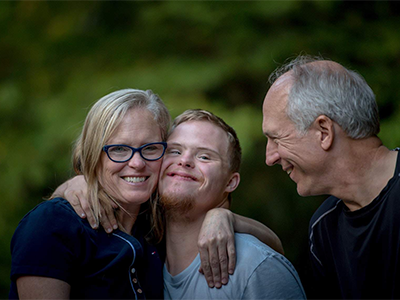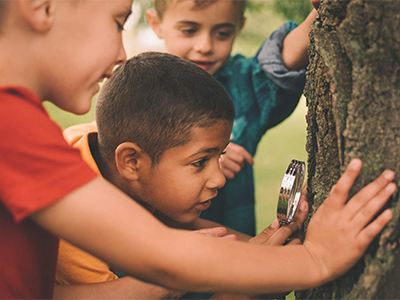 |
Building Relationships with Children and Youth |
2.00 |
An environment that fosters positive relationships between children, youth and adults is critical to creating a high quality program. This course supports participants in exploring how to build positive, meaningful relationships with children and youth, in order to plan programs that best meet their needs. |
 |
Coaching with Head and Heart |
2.00 |
Leaders and managers need strategies to support others in their own growth and development. In this course, participants will be introduced to a coaching process that supports individuals to make more conscious decisions, build off their strengths and internal resources and take new action. Participants will understand when coaching is needed, the mindset required, and the critical skills needed for effective coaching, including deep listening and inquiry. |
 |
Communicating with Families |
2.00 |
Communication and positive relationships with families improve when program staff recognize family members as partners. Staff can benefit from acknowledging their feelings about families and identifying how these feelings help or hinder working with families. This course provides participants the opportunity to identify their attitudes towards families, consider how their attitudes can enhance or detract from their ability to develop positive relationships with families, and examine how a program’s overall environment supports strong staff-family communication. |
 |
Community Resource Mapping |
2.00 |
English Learner families can often benefit from accessing low-cost/free services such as legal services, English classes, food banks etc. Afterschool Programs often do not have the resources to provide all of the services that they would like to provide to English Learners and their families.
This course serves as a compliment to Healthy Cultural Identities and Engaging Families and Communities, an in-person training offered through CalSAC's English Learner Training and Professional Development Project. This online course can also be used by a wide audience to help participants engage with an example of what Community Resource Mapping looks like. |
 |
Creating a Quality Summer Program |
2.00 |
CalSAC partnered with the Summer Matters campaign to create our Quality Summer Program training series. Summer months bring unique opportunities for learning outside the traditional school year and walls. High quality summer learning programs change students’ lives for the better with an opportunity to improve their academic achievement and readiness to learn. Developing quality programs requires intentional, ongoing development. Engage in activities that will help identify and strengthen the quality of your summer learning program.
Creating a Quality Summer Program is the first module in the Quality Summer Programming Training series. In this module, participants will learn about the importance of high quality summer learning programs for youth, elements of high-quality summer programs and effective tools to guide programs in their ongoing development of quality programming. |
 |
Creating an Inclusive Program |
2.00 |
With planning, training, and support, program staff can successfully include many children with special needs. Program staff must develop the skills necessary to assess the environment, materials, equipment, and activities to make the necessary modifications and accommodations so that all children and youth in their programs are successful. During this course, participants will discuss the law regarding inclusion as well as the attitude and reasonable accommodations needed to create an inclusive environment for children and youth with special needs. |
 |
Creating Respect and Safety |
2.00 |
Out-of-school time programs provide a safe space for children and youth, both physically and emotionally. Staff need to understand how to create safe environments to ensure that children and youth feel safe in order to fully participate in the program. This course will provide participants the opportunity to explore their own relationship to safety and support, set group agreements for the series, and discover their FRAME. |
 |
Cultural Competence: Diversity, Identity, and Engagement |
2.00 |
Many programs engage children, youth, families, and staff from diverse cultural backgrounds. In order to best serve their community, out-of-school time program staff need to develop the vocabulary and skills to engage with people from different cultures. During this course, participants will explore how culture can impact and shape individuals, examine their own cultural identities and how these identities may impact their interactions with others, and levels of engagement with diverse groups. |
 |
Developmental Trends 101 |
2.00 |
In order to provide developmentally appropriate programming, it's important to understand how children and youth develop physically, emotionally, and cognitively. This course will provide information about the developmental trends that are associated with different age-groups (K-8) and how these trends relate to day-to-day programming. |
 |
Effective Communication with Children and Youth |
2.00 |
We are constantly communicating with the children and youth in our program through our words and actions. It's important for program staff to think critically about their communication skills and habits in order to communicate effectively. During this course, participants will learn about effective and dynamic communication tools, strategies to check for understanding, and activities that engage children and youth in communication. |
 |
Elements of the Environment |
2.00 |
A positive environment for out-of-school time programs is as vital to the success of a program. It is important for the staff to understand the powerful effect the environment has in supporting the overall goals of school-age care and afterschool programs. Once staff members understand the role of the environment, they will be able to create an atmosphere in which children's and youth's growth and development are supported by the ways in which the space is arranged and managed, materials are chosen and maintained, and interpersonal relationships are developed. This course will help examine the indoor, outdoor and interpersonal environments of their program, gain knowledge on how to use all environments effectively, and identify a variety of ways to enhance the out-of-school time environment for children and youth. |
 |
Engaging the Community in Quality Summer Programs |
2.00 |
CalSAC partnered with the Summer Matters campaign to create our Quality Summer Program training series. Summer months bring unique opportunities for learning outside the traditional school year and walls. High quality summer learning programs change students’ lives for the better with an opportunity to improve their academic achievement and readiness to learn. Developing quality programs requires intentional, ongoing development. Engage in activities that will help identify and strengthen the quality of your summer learning program.
Engaging the Community in Quality Summer Programs is the third module in the Quality Summer Programming Training series. People need to know how important summer is to the children and youth in your program and across the state. Summer learning program staff are all torchbearers for quality summer opportunities. In this module, participants will gain a deeper understanding of elements of high-quality summer programs by identifying resources to help strengthen their summer program offerings, engaging in collaborative reflection and planning, and developing clear goals for the summer program. |
 |
Exploring Curriculum Activities |
2.00 |
Today, more than ever, programs are being asked to integrate academic activities into programming. Improving academic performance and achievement requires us to intentionally create opportunities for children and youth to learn and discover their own interests, strengths, and talents within the academic areas. This course offers an overview of the six curriculum areas as defined by the California Department of Education, provides sample activities that address these curriculum areas, and explores the importance of including academics in a well-balanced program. |
 |
Going Deeper: Supporting Social-Emotional Learning and Character Development |
2.00 |
It is important for staff to reflect on the practices they are implementing throughout the program to create environments in which young people can experience social-emotional learning and practice character skills. Just as important, staff must reflect on their own personal social-emotional and character competencies and how they demonstrate those in the program, acting as a role model for program participants. During this course participants will complete a self-reflection tool to identify actions they can take to strengthen their abilities to support social-emotional and character skill development. |
 |
Homework Assistance |
2.00 |
Supporting children and youth with their homework is a basic element of nearly all out-of-school time programs, yet it is something that can be challenging for many OST professionals. During this course, participants examine the importance of homework assistance, as well as strategies and skills to provide effective homework assistance. |
 |
I Belong: Supporting Social Awareness and Interpersonal Skills |
2.00 |
We all have lived full lives with varied experiences, both positive and negative. Whether we are aware or not, our experiences, including our social, political and cultural beliefs and background, affect our practice with youth. During this course, participants will learn about how culturally grounded beliefs and background affect our practice with youth, how to help raise our awareness of those factors, and reflect on current and new strategies that support the development young people’s social-awareness and interpersonal skills. |
 |
I Can: Supporting Growth Mindset and Self-Efficacy |
2.00 |
We all have areas in our life that we approach with a growth mindset and others we approach with a fixed mindset. In order for us to be positive role models to youth, we as adults need to reflect on our own mindsets and how they may impact how we behave at work and with youth. During this course, participants will learn about what self-efficacy and growth mindset are, explore our own mindset and the potential impact it has on youth, and reflect on current and new strategies to support the development young people’s growth mindset and self-efficacy. |
 |
Incentives and Motivation |
2.00 |
Motivation, incentives and rewards can help pull a team together and keep a successful staff on track. In our profession, incentives rarely come in the form of extra earnings, so we have to be creative in designing incentives. During this course, participants will look at several strategies for providing meaningful incentives for staff, as well as techniques to determine what motivates them and their staff. |
 |
Including Children and Youth with Disruptive Behaviors |
2.00 |
When working with children and youth, we encounter a wide range of behaviors. Effective behavior guidance strategies can help reduce the amount of time and energy spent addressing disruptive behaviors in the program. During this course, participants will explore the challenges of children and youth with disruptive behavior and learn strategies for effectively addressing these behaviors. |
 |
Integrating Academics and Enrichment |
2.00 |
It is essential that skills presented during the instructional day are reinforced by the learning opportunities presented in out-of-school time programs. Presenting materials in alternative learning formats encourages children and youth to participate, and it is through this participation that programs help promote mastery. During this course, participants will develop an understanding of the California Content Standards for Public Schools, including the Common Core Standards, and explore how to integrate them into a balanced afterschool program. |
 |
Introduction to Evaluation |
2.00 |
Quality programs operate with the idea that they will change, improve, and grow. Knowing how to identify areas needing improvement is the key to program quality, which must be continually evaluated to identify strengths and weaknesses. In this course, participants will learn what evaluation is, why it is important for programs, and ways they can evaluate their own programs. |
 |
Knowing Yourself as a Leader |
2.00 |
Leadership in out-of-school time programs ranges from simple observation to active participation in program design and implementation. Leadership is an on-going process involving continuous learning, and taking time to discover their values, goals, skills, talents, and strengths will help staff to understand the type of leaders they are and the type of leaders they desire to be. In this course, participants will learn to develop a personal mission statement and identify strengths and weaknesses in skill development. |
 |
Leading Teams and Organizations with Head and Heart |
2.00 |
As leaders, we must ensure that we are not only modeling social-emotional and character skills ourselves, but creating program environments for staff to thrive in these areas. Organizations can intentionally embrace and uphold practices that create safe environments for staff to develop and hone such skills individually and collectively, especially amongst change. In this course, participants will understand three stages of change, and how staff experience each. Participants will also become familiar with adaptive leadership strategies for managing change within organizations. |
 |
Leading with Head and Heart |
2.00 |
Those in leadership positions have a responsibility to both lead and manage.During this course, participants will understand the differences between the leadership and management, and the steps we can take to cultivate both. Participants will explore how leaders create safe, supportive environments by modeling self-awareness, interpersonal skills and growth mindset in how we lead and manage. |
 |
Shared Space 101 |
2.00 |
Afterschool programs share space and facilities that are used by other people and for other purposes during the school day. Learning how to accomplish this in a positive way is essential for effective programming. This course offers participants the opportunity to examine some common issues that can occur when sharing space, as well as strategies to effectively share space with a variety of people. |


























